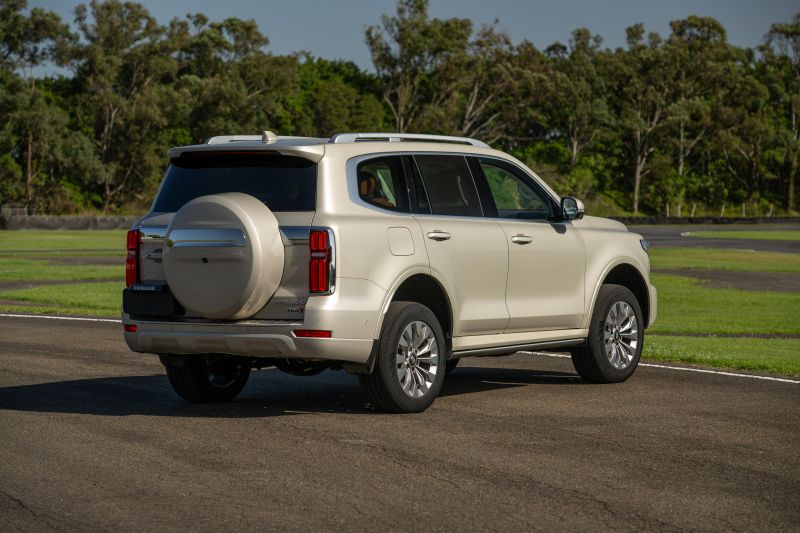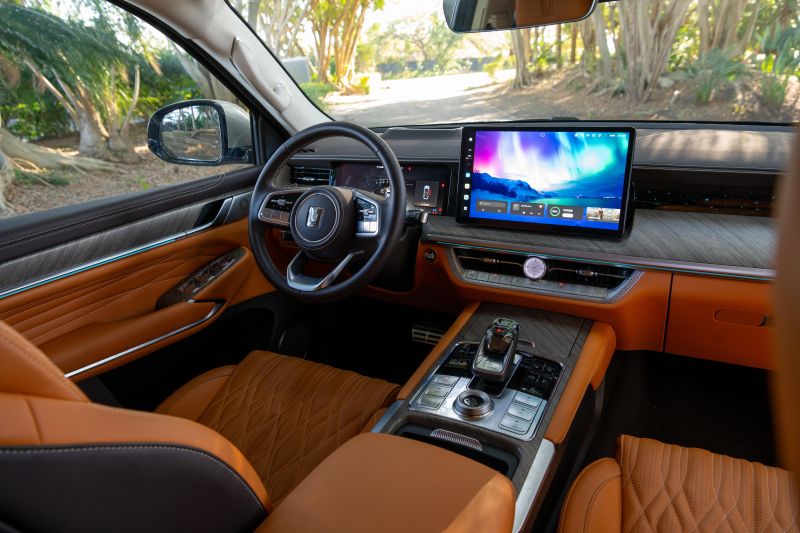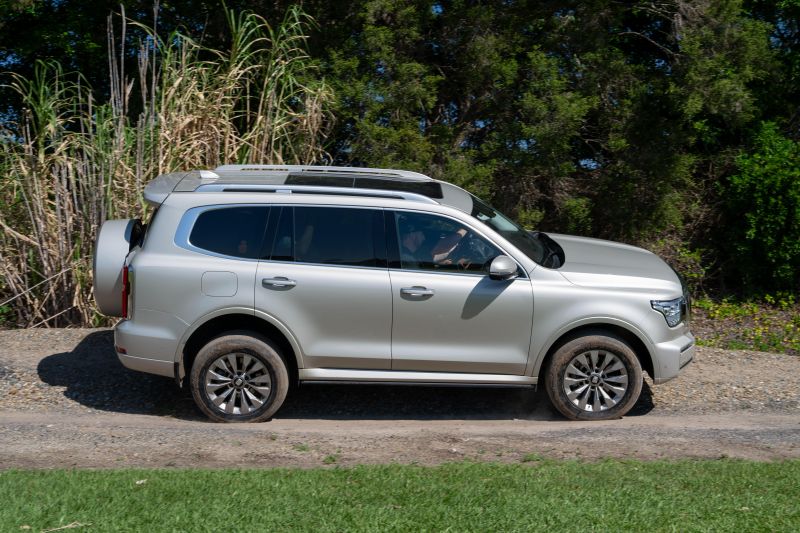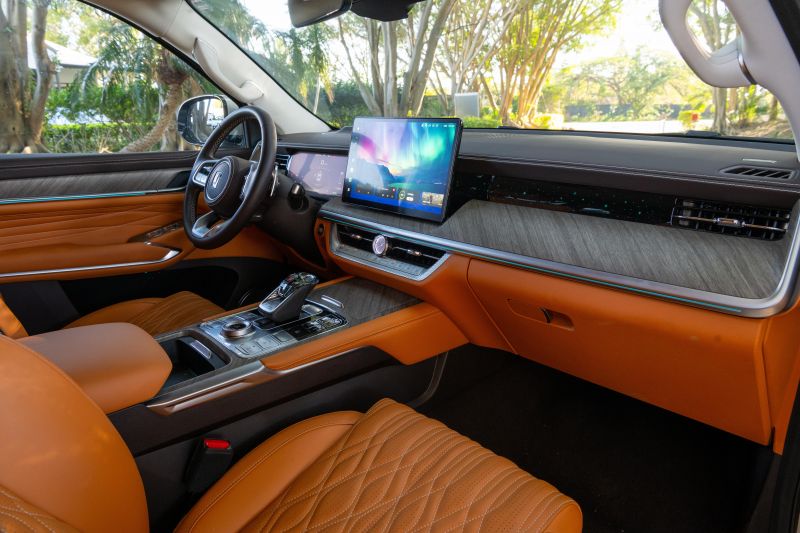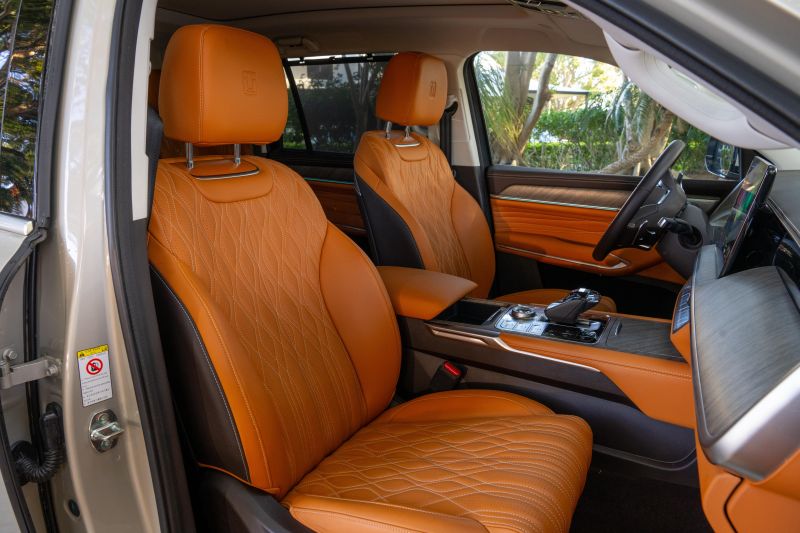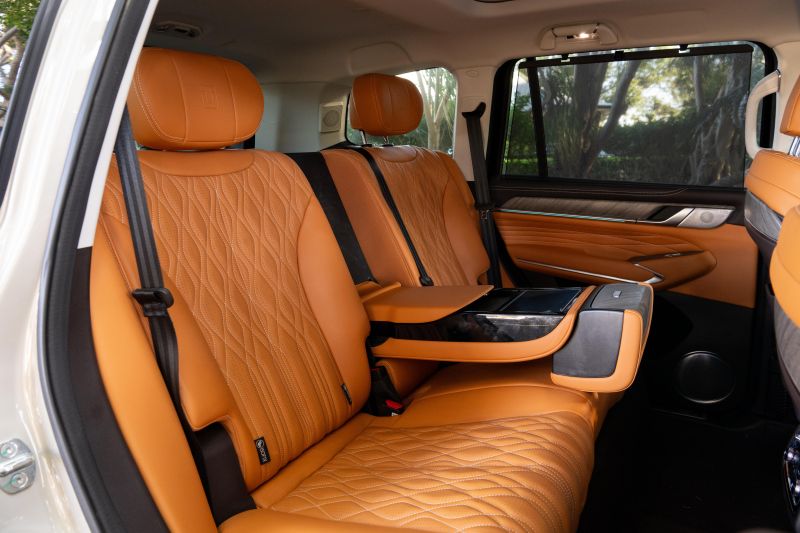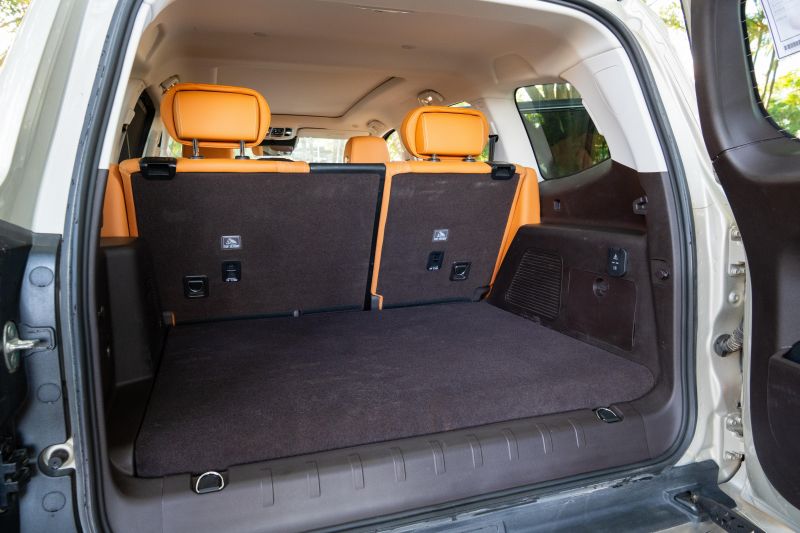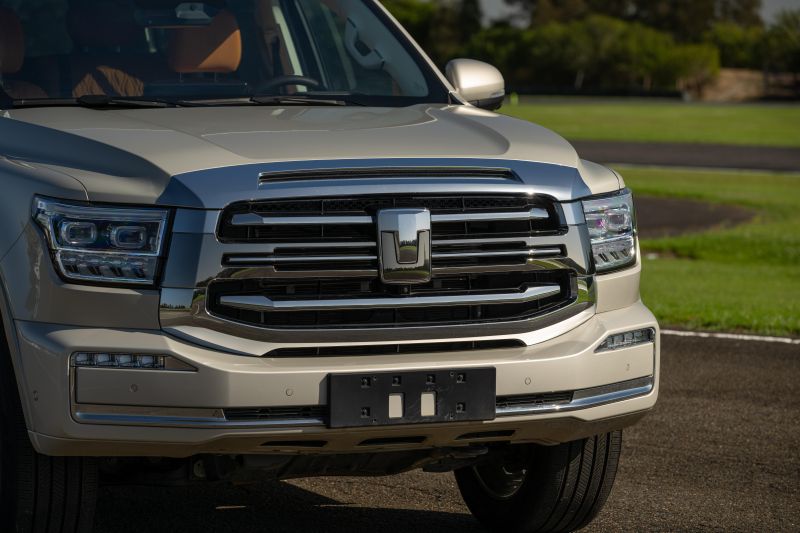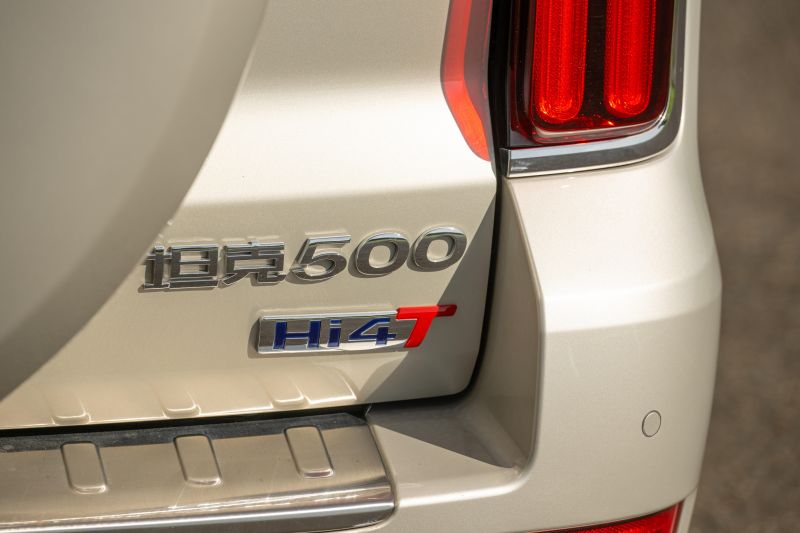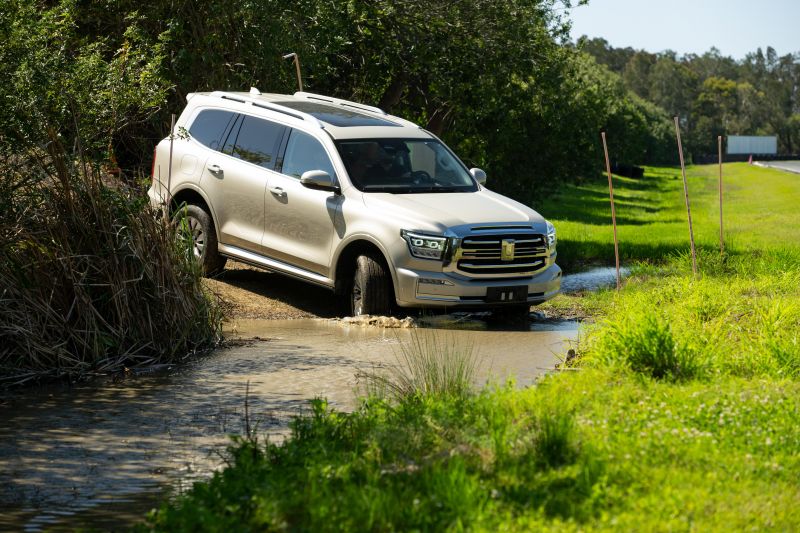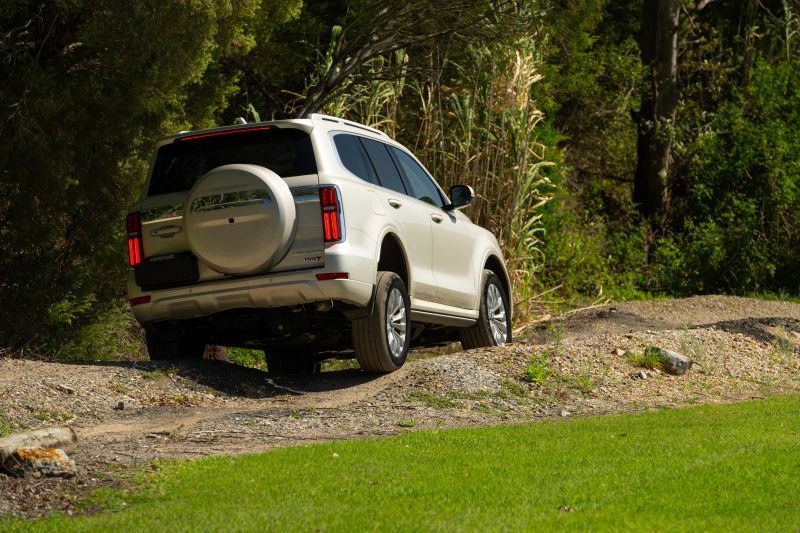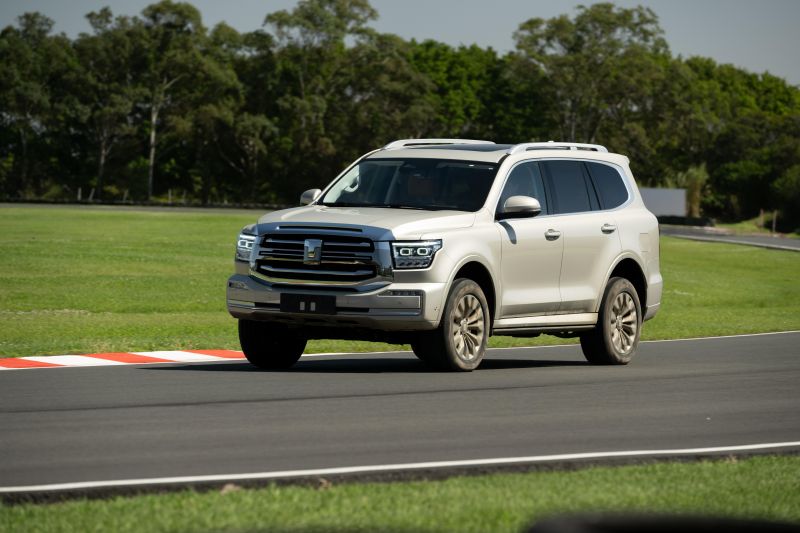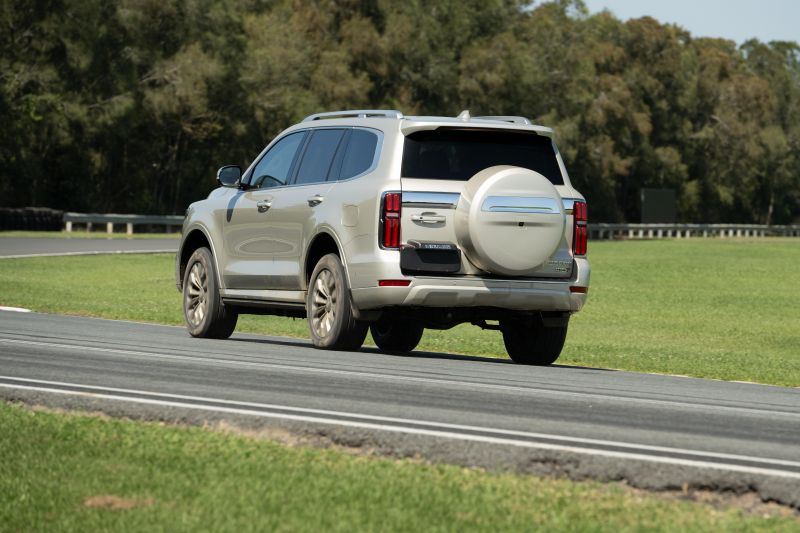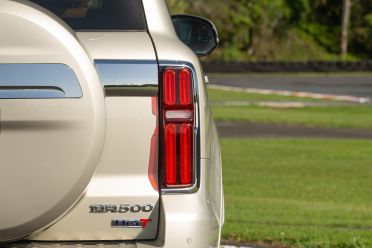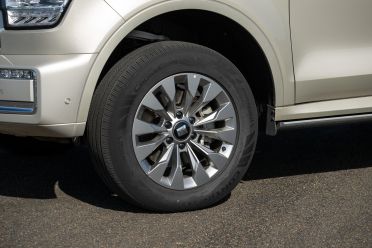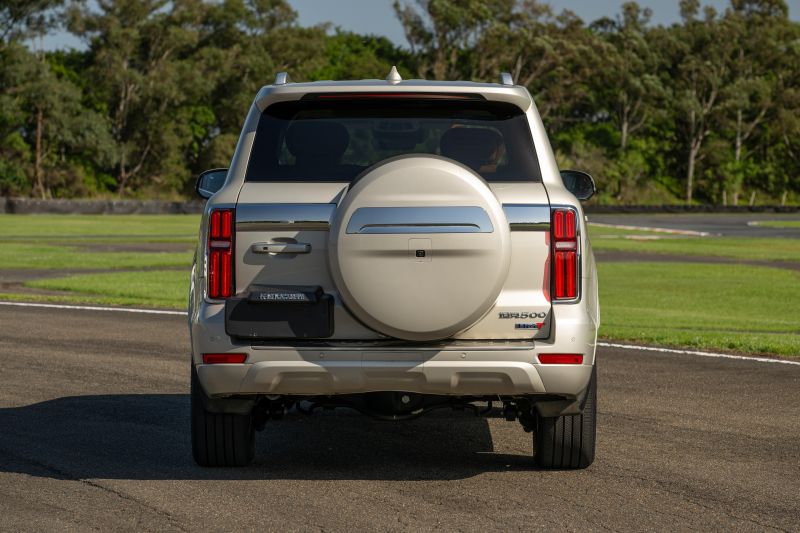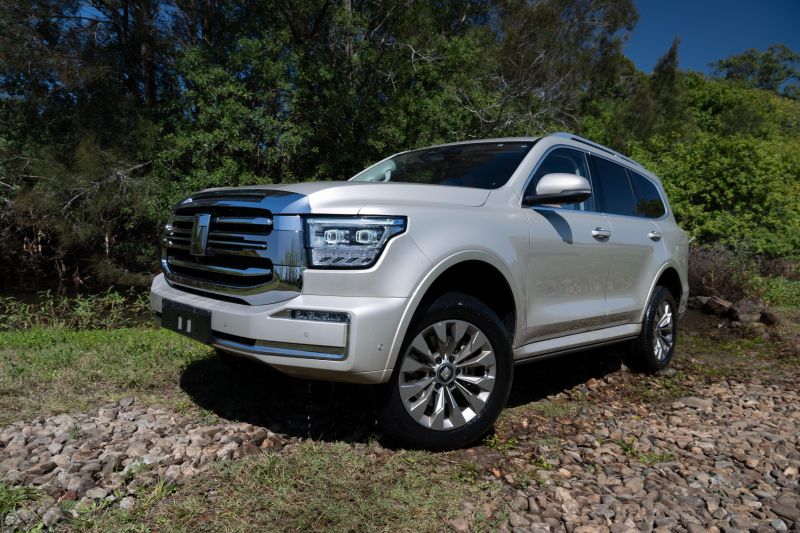GWM beat Toyota – Australia’s hybrid leader – to the local market with a hybrid off-roader. Now it’s set to do the same with a plug-in hybrid.
The Toyota Prado-rivalling GWM Tank 500 now offers the Chinese carmaker’s Hi4-T plug-in hybrid system in China, and the company intends to bring it here.
GWM aims to bring the Tank 500 Hi4-T here during 2025, and in the meantime it has brought an example of the electrified off-roader Down Under to show media and dealers.
The Tank 500 we got behind the wheel of had the steering wheel on the wrong side and Chinese badging on the tailgate, while all the screens were in Chinese which we had to use Google Lens to decipher.
Because it couldn’t be registered in Australia, we weren’t able to take it on the road. Instead, we had a brief drive around a track, and a brief drive on an off-road track.
With those caveats in mind, what did we think?

How much does the GWM Tank 500 Hi4-T cost?
GWM Australia hasn’t said how much the Tank 500 PHEV will cost.
“A premium on a plug-in hybrid can range anywhere from $6000 to $15,000. It’s going to depend on the size of the battery pack,” said GWM Australia marketing and communications boss Steve Maciver.
“Range and battery size is what defines pricing.”
GWM Australia managing director Charles Zhao said the company is looking at making pricing of its PHEVs competitive.
“I believe with the future [New Vehicle Efficiency Standard] regulations, maybe we’ll consider to use some of the scores that PHEVs can earn to compensate [for] the price increase of the PHEV to make the price of the PHEV more competitive,” he told CarExpert.
The Tank 500 range currently opens in Australia at $66,490 drive-away for the Lux Hybrid, rising to $73,900 drive-away for the Ultra Hybrid.
The PHEV version won’t find much in the way of competition, regardless of price point. Its closest rival is the Jeep Grand Cherokee 4xe, which is now being offered for $111,450 before on-road costs after a significant price cut.
There’s also the less rugged Kia Sorento and Mazda CX-60 PHEVs, as well as luxury-brand models like the BMW X3 xDrive30e.
What is the GWM Tank 500 Hi4-T like on the inside?
The GWM Tank 500 PHEV’s interior is essentially unchanged from the existing hybrid, apart from the absence of a third row of seating.
The load floor is also slightly higher due to the battery. This eats into cargo space, but not significantly. There’s 646L of volume behind the second row, compared to 795L in the Tank 500 Hybrid.
This expands to 1400L with the second row folded, compared to 1459L in the hybrid. The spare wheel continues to be mounted on the tailgate, so at least that isn’t sacrificed to fit a larger battery.
As for the rest of the interior, it’s as classy as the regular Tank 500 Hybrid. That is to say, it has a vastly more upscale ambience than body-on-frame off-roaders like the Ford Everest and Isuzu MU-X.
It even features an analogue clock, which may have become a cliché over the years for brands trying to project premium aspirations, but nevertheless it’s an elegant touch. There are swathes of wood-look trim which provides some contrast, but looks a little bit Laminex.
More modern touches include the digital panel stretching across the dash with little stars, as well as strips of colour-adjustable ambient lighting.
The seats and door panels are finished in quilted leather trim, which in our tester was finished in a bold orangey-tan. This contrasts with black soft-touch trim used for the tops of the dash and doors, which like the orange trim features pale contrast stitching.
There’s a mix of silvery and gloss black trim, including on the steering wheel and centre console – we’re glad there’s at least a partial reprieve from gloss black trim.
Those leather-upholstered seats are plush and comfortable, and feature heating and ventilation.
There’s a huge 14.6-inch touchscreen infotainment system, though as our tester was a Chinese-market model we didn’t explore it too much – as much as I’d like to be able to, I don’t understand Chinese.
Step into the second row and there’s a comfortable bench with a fold-down armrest, air vents, climate controls and USB outlets.
There’s plenty of legroom and headroom, and the lovely materials from the front of the cabin carry through back here.
What’s under the bonnet?
The Tank 500 Hi4-T pumps out 45kW more power and 102Nm more torque than the hybrid, but it’s also 398kg heavier.
| Specifications | GWM Tank 500 Hi4-T |
|---|---|
| Engine | 2.0L 4cyl turbo |
| Engine outputs | 180kW and 380Nm |
| Electric motor outputs | 120kW and 400Nm |
| System outputs | 300kW and 750Nm |
| 0-100km/h time | 6.9 seconds |
| Battery | 37.1kWh ternary lithium (NCM) |
| Max DC charging rate | 50kW |
| Max AC charging rate | 6.6kW |
| Transmission | 9-speed hybrid transmission |
| Drive type | Four-wheel drive |
| Fuel economy (claimed) | 2.06L/100km (WLTC) |
| Electric driving range | 110km (WLTC) |
| CO2 emissions (claimed) | 60g/km |
| Fuel type | 91 RON |
| Fuel tank | 70L |
| Kerb weight | 2830kg |
| Payload | 565kg |
| Braked towing capacity | 3000kg |
| Gross vehicle mass (GVM) | 3395kg |
GWM claims when the battery is running low, combined fuel consumption works out to be 8.8L/100km on the WLTC cycle. The Tank 500 Hybrid’s claimed fuel economy is 8.5L/100km.
We weren’t able to adequately test the Tank 500’s fuel consumption and electric range claims, but we hope to when we get more time with the vehicle.
Its fuel tank is 10L down on the hybrid’s, but towing capacity and gross vehicle mass are unchanged. The PHEV also has vehicle-to-load (V2L) capability, allowing you to power external appliances. Maximum output is 3.3kW.
The battery features a pre-conditioning feature, allowing you to ensure it’s primed and ready to get the most efficient charge before you pull up to a plug.
How does the GWM Tank 500 Hi4-T drive?
Our driving was limited to a few laps of the track at Norwell Motorplex, plus a drive through an off-road track on the property.
This track consisted of a small hill climb; a rutted track where we could get one wheel in the air; a sand pit; a short, rocky trail; and a couple of water crossings.
Much of this potentially could have been tackled entirely in 4H, but we did put it into 4L and play around with a few different off-road functions.
The hill descent control is easy to activate and use, while we engaged the locking rear differential to help us more easily tackle the moguls.
There are also centre and front differential locks.
We had no trouble clearing the water crossings; the Tank 500 PHEV has the same 800mm wading depth as its hybrid counterpart.
In 4L mode, we did notice it would hold first gear to about 4000rpm and then abruptly shift to second. Otherwise, the Tank 500 proved refined and comfortable across the short course.
We found the petrol engine would fire up even if we were trying to keep it electric-only mode, but it’s possible to do some silent bush-bashing with light enough throttle inputs.
GWM’s typically superb camera quality comes in especially handy off-road, allowing you to see what’s ahead of you and to the sides. This helps you place the vehicle on rough and narrow tracks.
On the race track, it’s clear this is a big, body-on-frame off-roader and not something like a BMW X5. That came as no great surprise.
Despite this the Tank 500 impressed with its refinement. Power delivery is smooth, and the cabin is quite well-insulated – we could barely hear the tyres howling as we did in the SUV what we suspect no Tank 500 owner will ever do.
Under full load you can hear the turbocharged petrol engine working away, but it doesn’t become objectionably loud.
The hefty 2830kg kerb weight means the 0-100km/h time is 6.9 seconds – competitive, but not rocketship fast despite the high outputs.
We weren’t able to gauge what ride comfort is like on the surfaces that sit between the extremes of a rutted off-road course and a glass-smooth track.
The Tank 500 Hi4-T, like the hybrid, features a multi-link live axle at the rear with coil springs.
We did observe the steering has good weighting, though as with many hybrids there’s an odd feel to the brake pedal.
| Off-road dimensions | GWM Tank 500 Hi4-T | GWM Tank 500 Hybrid |
|---|---|---|
| Ground clearance | 213mm | 224mm |
| Approach angle | 29.5 degrees | 30 degrees |
| Departure angle | 24 degrees | 24 degrees |
| Ramp breakover angle | 22 degrees | 22.5 degrees |
| Wading depth | 800mm | 800mm |
What do you get?
We don’t know how the Tank 500 Hi4-T will be specified in Australia, but the local hybrid lineup provides plenty of clues.
Tank 500 Lux Hybrid highlights:
- 18-inch alloy wheels
- Front, centre and rear locking differentials
- 4H and 4L modes
- Off-road cruise control
- Rain-sensing wipers
- Single-pane sunroof
- LED headlights
- Automatic high-beam
- Wireless phone charger
- Tri-zone climate control with second-row controls
- Leatherette upholstery
- Heated front seats
- 8-way power driver’s seat with 4-way lumbar
- 4-way power passenger seat
- 12.3-inch digital instrument cluster
- 14.6-inch touchscreen infotainment system
- DAB+ digital radio
- Wireless Apple CarPlay and Android Auto
- 8-speaker sound system
- Proximity entry with push-button start
- Rear privacy glass
- Soundproof windscreen
- Power-folding exterior mirrors
- Tyre pressure monitoring
Ultra Hybrid adds:
- Panoramic sunroof
- Power-retractable side steps
- Soft-close tailgate
- Chrome-accented door handles
- Memory and welcome function for driver’s seat
- Heated steering wheel
- Nappa leather upholstery
- Ventilated and massaging front seats
- 6-way power passenger seat
- Ventilated outboard rear seats
- Head-up display
- 12-speaker Infinity sound system
- Active noise cancellation
- Soundproof rear door glass
- Puddle lights
- Manual rear window shades
- 64-colour ambient lighting
It’s worth noting our Hi4-T tester was a top-spec example with 19-inch alloy wheels.
Is the GWM Tank 500 Hi4-T safe?
The GWM Tank 500 hybrid has a five-star safety rating from ANCAP, based on testing conducted in 2024.
This hasn’t been applied to the plug-in hybrid just yet, but GWM is hopeful.
“It should carry over, obviously you need to do the engineering analysis with ANCAP to make sure that that battery pack, the weight of the vehicle et cetera won’t impact any of the existing testing that we’ve done,” said Steve Maciver, GWM Australia’s head of marketing and communications.
Standard safety equipment on the Tank 500 Hybrid includes:
- 7 airbags
- Autonomous emergency braking
- Intersection assist
- Adaptive cruise control
- Blind-spot monitoring
- Lane centring
- Lane-keep assist
- Emergency lane-keep assist
- Front cross-traffic assist
- Rear cross-traffic assist
- Safe exit warning
- Traffic sign recognition
- Surround-view camera
- Front and rear parking sensors
How much does the GWM Tank 500 Hi4-T cost to run?
The Tank 500 Hybrid, like the rest of the GWM range, is backed by a seven-year, unlimited-kilometre warranty.
It also comes with seven years of roadside assist, and seven years of capped-price servicing.
GWM hasn’t confirmed what service pricing will look like for the PHEV, though we’d expect overall warranty and roadside assist coverage to be the same.
CarExpert’s Take on the GWM Tank 500 Hi4-T
PHEV sales may not be anywhere near hybrid or EV sales in Australia, but they’re growing at a high rate – and this plug-in Tank 500 shapes as a compelling new offering for our market.
You lose little in terms of off-road ability compared to a Tank 500 Hybrid, while gaining an impressive amount of electric-only range.
The Hi4-T also keeps the hybrid’s surprisingly upscale interior, albeit with the unfortunate loss of a third row of seating.
The Tank 500 Hi4-T will effectively fill a vacuum. It’s only real rival is the Grand Cherokee 4xe, of which Jeep could only sell 17 examples in the first half of this year – likely because of its high price.
That of course leads to the big question: how much will the Tank 500 Hi4-T cost?
Given there will be a premium, we don’t expect it to become the best-selling powertrain in the lineup, but this impressive GWM could make headway with buyers who want to balance off-road capability with electric-only driving.
Click the images for the full gallery
MORE: Buy a GWM Tank 500
MORE: Everything GWM Tank 500





